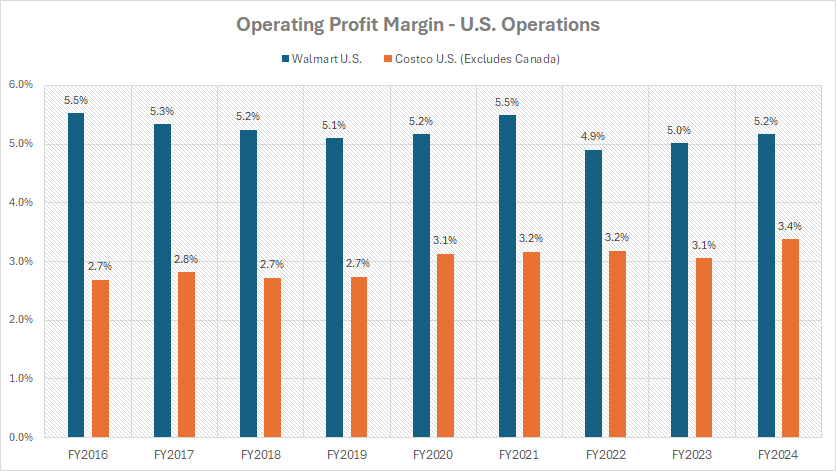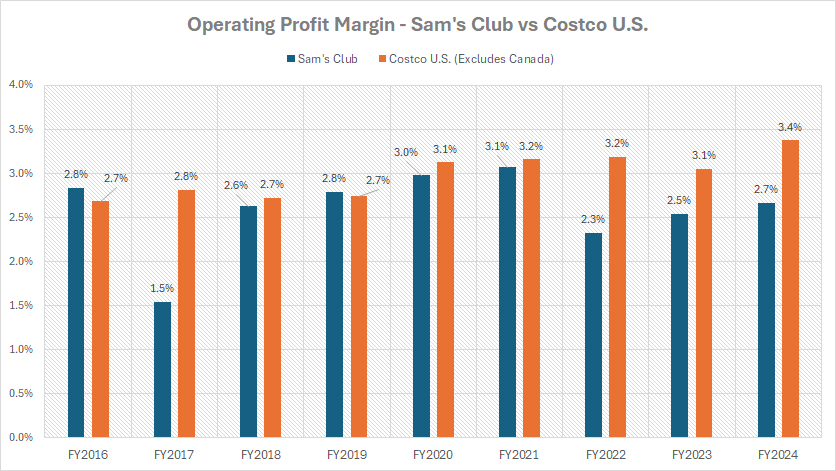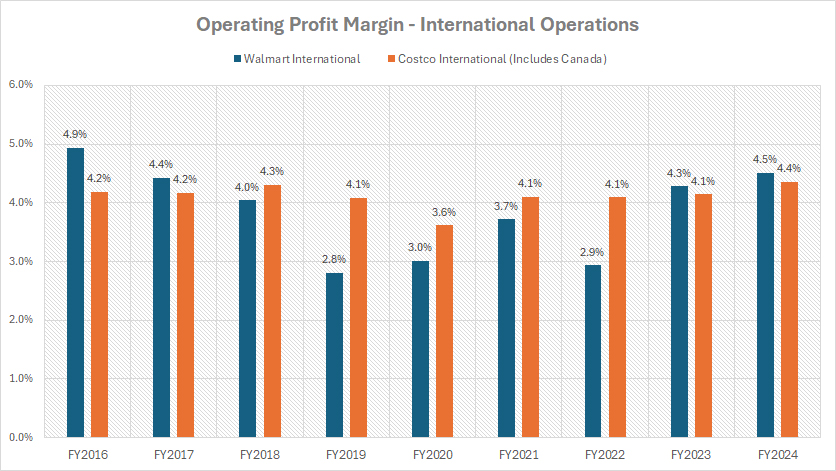
Wholesaler. Pexels Images.
This article compares the profit margin of Walmart and Costco. We will look at both companies’ operating profit margins.
In addition to the U.S. operations, we also compare the operating profit margins of both retailers’ international segments.
Let’s dive in!
For the detailed statistics of Walmart and Costco’s profitability and margins, you may find more resources on these pages:
Walmart
Costco
Walmart vs Costco
- Costco vs Walmart: profit comparison in the U.S. and International segments,
- Walmart vs Costco: number of stores and store size,
Please use the table of contents to navigate this page.
Table Of Contents
Definitions And Overview
O2. Why does Walmart generate better profit margin than Costco?
U.S. Segment
A1. Walmart U.S. vs Costco U.S.
Sam’s Club
International Segment
C1. Walmart International vs Costco International
Summary And Reference
S1. Insight
S2. References and Credits
S3. Disclosure
Definitions
To help readers understand the content better, the following terms and glossaries have been provided.
Walmart vs Costco in Fiscal Schedules: Walmart’s FY2025 financial results are compared against Costco’s FY2024 results due to differences in their fiscal year reporting.
Walmart operates on a fiscal calendar that ends on January 31, meaning its FY2025 includes February 2024 to January 2025. In contrast, Costco follows a fiscal year ending in August, making its FY2024 cover September 2023 to August 2024.
Since Costco’s FY2025 results are not yet available at the time of Walmart’s latest fiscal report, analysts and industry comparisons often use Costco’s FY2024 as the closest match when evaluating the two retailers’ financial performance.
This approach ensures that the most recent annual results for both companies are used while accounting for their differing fiscal schedules.
Why does Walmart generate better profit margin than Costco?
Walmart consistently achieves higher profit margins than Costco due to several key factors:
-
Business Model Differences: Walmart operates on a traditional retail model, selling products at everyday low prices without requiring memberships. Costco, on the other hand, relies on a membership-based warehouse model, which limits its customer base but allows for bulk sales at lower margins.
-
Scale and Revenue: Walmart has a significantly larger footprint, with over 10,000 stores worldwide compared to Costco’s 876 warehouses. This scale enables Walmart to generate much higher revenue — $674 billion in fiscal year 2025 versus Costco’s $254 billion in fiscal year 2024.
-
Product Assortment and Pricing Strategy: Walmart offers a vast range of products across multiple categories, including groceries, electronics, and apparel, allowing it to optimize pricing and margins. Costco focuses on a limited selection of bulk items, which keeps costs low but also restricts margin expansion.
-
Operational Efficiency: Walmart leverages its massive supply chain and advanced logistics to negotiate better terms with suppliers, reducing costs and improving profitability. Costco, while efficient, prioritizes passing savings onto members rather than maximizing margins.
-
Revenue Streams: Walmart generates revenue primarily from product sales, whereas Costco relies heavily on membership fees. While Costco’s membership model provides stability, it doesn’t contribute significantly to profit margins compared to Walmart’s diversified revenue streams.
While both retailers are highly successful, Walmart’s broader market reach, diversified revenue streams, and operational scale give it a significant advantage in generating better profit margins.
Walmart U.S. vs Costco U.S.
U.S.-segment-operating-profit-margin
(click image to expand)
For the definition of the fiscal schedules of Walmart and Costco, you may refer to this section: Walmart vs Costco in fiscal schedules.
Walmart U.S. generates much better profit margins than Costco U.S., as shown in the chart above. In fiscal year 2024, Walmart U.S. segment’s operating profit margin was significantly higher than that of Costco U.S. segment.
The following table shows more detailed results:
Operating Profit Margin in FY2024:
| Retailer | Operating Profit Margin (%) |
|---|---|
| Walmart U.S. | 5.2% |
| Costco U.S. | 3.4% |
3-Year Average from FY2022 to FY2024:
| Retailer | Operating Profit Margin (%) |
|---|---|
| Walmart U.S. | 5.0% |
| Costco U.S. | 3.2% |
5-Year Average from FY2020 to FY2024:
| Retailer | Operating Profit Margin (%) |
|---|---|
| Walmart U.S. | 5.1% |
| Costco U.S. | 3.2% |
9-Year Trend from FY2016 to FY2024:
| Retailer | Operating Profit Margin (%) |
|---|---|
| Walmart U.S. | 5.2% |
| Costco U.S. | 3.0% |
Sam’s Club vs Costco U.S.
Sams-Club-operating-profit-margin
(click image to expand)
For the definition of the fiscal schedules of Walmart and Costco, you may refer to this section: Walmart vs Costco in fiscal schedules.
Sam’s Club’s operating profit margin is comparable with that of Costco U.S., as illustrated in the chart above. However, in recent years, Sam’s Club’s operating profit margin has significantly declined, making it considerably lower than that of Costco U.S.
The following table shows more detailed results:
Operating Profit Margin in FY2024:
| Retailer | Operating Profit Margin (%) |
|---|---|
| Sam’s Club | 2.7% |
| Costco U.S. | 3.4% |
3-Year Average from FY2022 to FY2024:
| Retailer | Operating Profit Margin (%) |
|---|---|
| Sam’s Club | 2.5% |
| Costco U.S. | 3.2% |
5-Year Average from FY2020 to FY2024:
| Retailer | Operating Profit Margin (%) |
|---|---|
| Sam’s Club | 2.7% |
| Costco U.S. | 3.2% |
9-Year Trend from FY2016 to FY2024:
| Retailer | Operating Profit Margin (%) |
|---|---|
| Sam’s Club | 2.6% |
| Costco U.S. | 3.0% |
Walmart International vs Costco International
International-segment-operating-profit-margin
(click image to expand)
For the definition of the fiscal schedules of Walmart and Costco, you may refer to this section: Walmart vs Costco in fiscal schedules.
Outside of the U.S., Walmart International generates about the same profit margin as Costco International (inclusive of Canada). In fiscal year 2024, both retailers’ operating profit margin reached around 4.5% for their international operations.
The following table shows more detailed results:
Operating Profit Margin in FY2024:
| Retailer | Operating Profit Margin (%) |
|---|---|
| Walmart International | 4.5% |
| Costco U.S. | 4.4% |
3-Year Average from FY2022 to FY2024:
| Retailer | Operating Profit Margin (%) |
|---|---|
| Walmart International | 3.9% |
| Costco U.S. | 4.2% |
5-Year Average from FY2020 to FY2024:
| Retailer | Operating Profit Margin (%) |
|---|---|
| Walmart International | 3.7% |
| Costco U.S. | 4.1% |
9-Year Trend from FY2016 to FY2024:
| Retailer | Operating Profit Margin (%) |
|---|---|
| Walmart International | 3.9% |
| Costco U.S. | 4.1% |
Insight
Walmart’s superior profit margins compared to Costco stem from fundamental differences in their business models, scale, and operational efficiency. Walmart operates as a traditional retailer, offering a vast assortment of products across multiple categories without requiring memberships.
This broad accessibility allows Walmart to maximize foot traffic and revenue potential, translating into higher profit margins. Costco, by contrast, follows a membership-based warehouse model, which limits its customer base but enables bulk purchasing with lower markups. While this strategy fosters loyalty, it restricts margin expansion since the company prioritizes passing savings to its members.
Scale plays a crucial role in Walmart’s profitability advantage. With over 10,000 stores worldwide, Walmart benefits from significant economies of scale, enabling cost reductions in procurement, logistics, and operational expenses. In contrast, Costco operates around 876 warehouses, limiting its ability to leverage similar efficiencies. Walmart’s massive distribution network allows for optimized inventory management and better supplier negotiations, securing favorable terms that enhance margins.
Additionally, Walmart’s diversified revenue streams contribute to stronger profit margins. The company generates income primarily through product sales but also earns from financial services, advertising, and e-commerce. In contrast, Costco relies heavily on membership fees as a key component of its financial model. While membership revenue provides stability, it does not significantly improve profitability compared to Walmart’s broader, high-margin revenue sources.
Operational efficiency is another critical factor distinguishing Walmart from Costco. Walmart has invested heavily in technology-driven logistics, automation, and supplier collaboration to improve cost management. Its scale and reach enable better price negotiations with suppliers, lowering input costs while maintaining competitive pricing.
Meanwhile, Costco operates with a leaner cost structure, focusing on efficiency through bulk purchasing and limited product selection. While effective, this model prioritizes lower costs over margin growth. Overall, Walmart’s ability to leverage its expansive scale, diverse revenue streams, and optimized operations enables it to consistently achieve better profit margins than Costco.
References and Credits
1. All financial figures presented were obtained and referenced from Walmart and Costco’s quarterly and annual reports published on the respective investor relations pages: Walmart Investor Relations and Costco Investor Relations.
2. Pexels Images.
Disclosure
We may use artificial intelligence (AI) tools to assist us in writing some of the text in this article. However, the data is directly obtained from original sources and meticulously cross-checked by our editors multiple times to ensure its accuracy and reliability.
If you find the information in this article helpful, please consider sharing it on social media. Additionally, providing a link back to this article from any website can help us create more content like this in the future.
Thank you for your support and engagement! Your involvement helps us continue to provide high-quality, reliable content.



